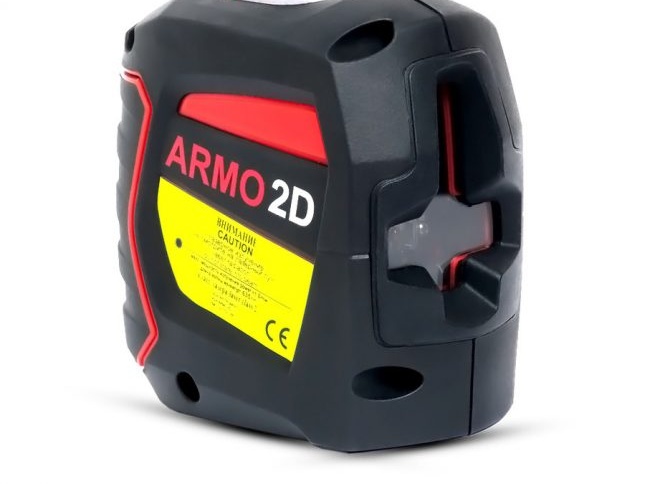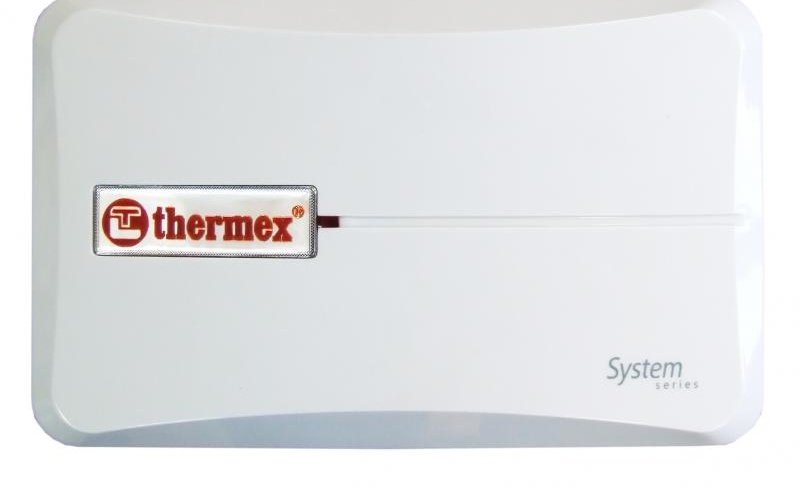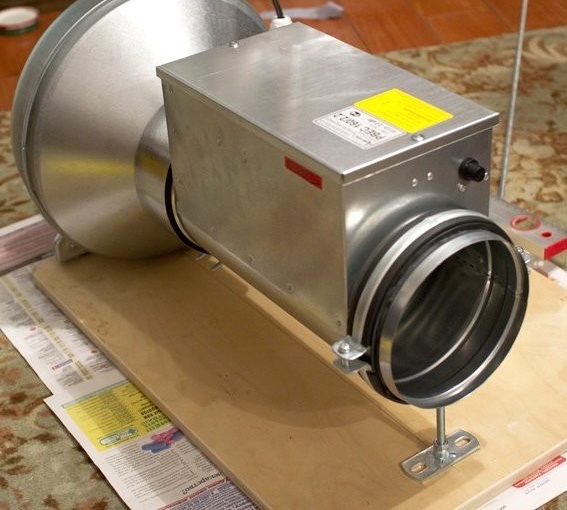Device and use of the laser level
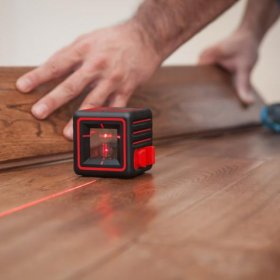
Production of construction or repair work, interior decoration, installation of suspended ceilings, pouring floor screed - this is not a complete list of the possible application of the laser level. A device that allows you to instantly get a display of a vertical or horizontal straight line or plane using one or more light rays, is of great help when performing marking work.
The greatest need is experienced by specialists involved in repair and finishing works, but for a home master such a device is useful and can significantly facilitate the work, improve its quality, and reduce lead time. The cost of the laser level is quite high, therefore, for the correct choice of a suitable model, you must have a clear idea of the device and the technical characteristics of the devices.
Content
What is a laser level?
Laser level or level - a device that performs the construction of light lines on the vertical or horizontal planes of the room. The purpose of the device is to accelerate and ensure high precision marking of walls, floors or ceilings of residential or public buildings. Traditional methods of marking work require considerable time. Plumb bumps and bubble building levels are used, which can provide sufficient accuracy of measurements, but allow a high error, instability of readings. This is especially evident in large rooms with uneven planes, where it is very difficult to apply an even line by traditional methods. We have to pull the cords, repeatedly checking their position, monitor their condition, while the laser level only needs to be turned on. These operations require an assistant, and one person is perfectly controlled with the laser level.
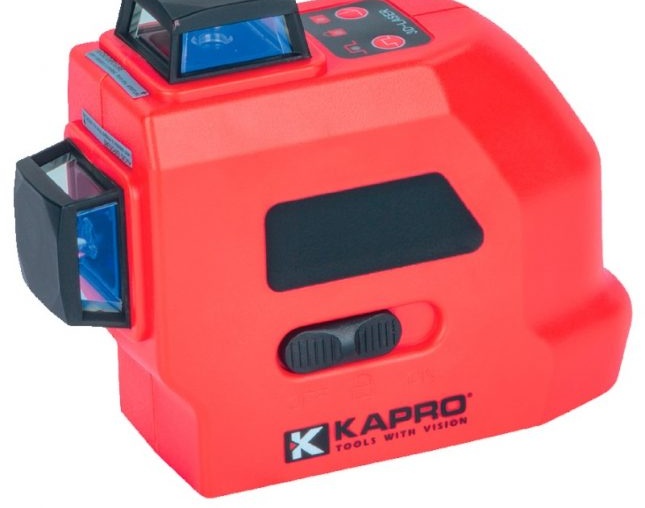
Accuracy and speed of marking many times increase the productivity of work, provide high quality finishing or installation of equipment
The operation of the device is based on the use of one, two or three laser beams and a scanning or focusing system, depending on the type of construction. A ray of light emitted by a laser passes through a certain focusing system and shows a point, a straight line or a plane (one, two or three), allowing you to quickly and accurately apply the necessary marks to the surface or begin work directly along visible lines.The device is mounted on a flat dense platform or on its own tripod, providing stability and immobility of the device.
Types of devices
There are three main groups of laser levels that differ from each other in purpose, complexity of design and number of rays.
Spot (axis builder)
The device is capable of projecting a point without forming a straight line. For horizontal marking, it is necessary to sequentially mark two points at different ends of the wall and draw a line between them or pull the cord.
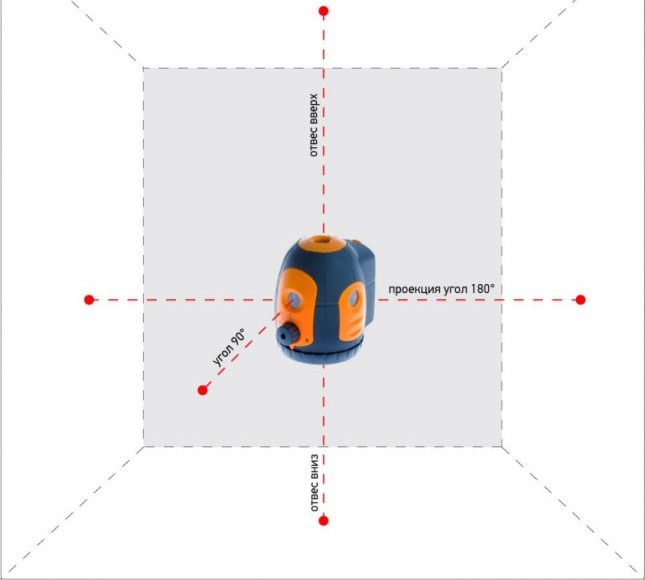
The point has maximum distinctness on the plane, therefore the radius of action of the axis builders is noticeably greater than that of other types
It is necessary to perform some additional actions, which complicates the measurements somewhat, but the accuracy and the ability to determine the distance using a laser range finder, as well as the presence of up to five rays (in the most advanced models) increase the accuracy of the work.
Crossliner (line builder)
This type of levels allows you to build a light line on the plane. The beam is transmitted through a prism that rotates it through 120 °, due to which a direct thin strip appears on the surface.

It’s convenient to work with the crossliner when the planes are uneven, have a complex relief or many elements that make traditional marking methods impossible
Separate models of such devices make it possible to simultaneously obtain horizontal and vertical main lines, and up to 5 additional ones. The features of the level make it possible not to apply any markings on the wall or floor, but to work directly along the projected light axes.
Rotary Plane Builder
In this case, it becomes possible to obtain one or more planes (usually one horizontal and two vertical).

The rotational level is indispensable for leveling the floor, pouring screed, installing a stretch ceiling and other work with planes that require precision and high quality
A ray of light rotates around its axis, projecting a continuous light strip building a plane around the source. This allows you to determine the degree of slope of the floor or ceiling, to control the vertical walls or partitions.
Technical characteristics of levels
There are a large number of models of laser levels of all types. They have certain technical characteristics that allow you to get a general idea of the capabilities of each device.
Main characteristics:
- measuring range. The parameter that determines the distance at which the beam of the device can be distinguished. It depends on the power of the light source. Individual samples have a range of up to 300 m, but most levels operate at 20 m. The higher the range, the more opportunities the devices have, especially when working outdoors in bright light;
- number of rays and their color. Most modern laser level models have 5 beams, but different options are possible. The more rays, the higher the capabilities of the device that allows you to project openings, installation axes of door, window units or equipment. Devices have the ability to turn off the rays, unnecessary at the moment. The color of the beam determines its clarity and the ability to use in bright light conditions (outdoors). There are devices with red or green rays. Red is considered less bright and distinct, green - allows you to work on the street. To enhance visibility, special glasses are used that cut off individual frequencies of the light wave and make it possible to clearly distinguish lines from levels;
- type of alignment and the ability to disable it. Determines how to set the horizontal or vertical. There are devices with manual, pendulum and electronic type of installation. The most convenient option is automatic alignment (leveling) of the plane, eliminating the need for the owner to install manually. Allowable error reaches 5%, on some devices it is even less.If the deviation of the instrument from the horizontal exceeds 5%, an audible signal sounds, warning of a failure of the installation. In such cases, you have to act manually. Also appreciated is the ability to disable automatic installation, necessary when working on slopes. In such conditions, the device will not be able to independently provide the horizontal and will continuously signal a violation of the position, so the setting is turned off and the position is displayed manually.
- accuracy and measurement error. Laser levels have three levels of accuracy, corresponding to household, semi-professional and professional devices. The degree of permissible deviation from the true value decreases with increasing class of the device. Household devices have an error of 5-8 mm per 10 m, semi-professional - 3-5 mm at 10 m, professional provide accuracy from 0.5 to 3 mm per 10 m;
- Type of food. There are two options for powering devices - battery and battery. The first use rechargeable batteries like on mobile phones. They cost more, the operating time before recharging is about 20 hours, but the number of charging cycles is large. Battery powered devices are cheaper, one set provides about 60 hours of continuous operation, but after that you will have to buy a new set;
- Dimensions and weight. The sizes of the laser levels are relatively small, individual devices differ significantly from other samples. The reasons for this difference lie in the design, capabilities and type of housing. The most successful are small and lightweight devices, since they have to be transported along with a large number of other tools and devices. For home use, when there is no need to constantly carry the laser level from one place to another, a more massive device is suitable, although household samples do not differ in large dimensions;
- enclosure protection class. The conditions of use of the device can be different - high dust content, when working in an open area, precipitation, mechanical damage are possible. Case material is usually impact-resistant types of plastics. Often there are falls from reference sites, which poses a threat to the integrity of the device. The standard level of protection of the case is indicated by the IP54 marking and ensures safety in the event of a fall, eliminates the ingress of dust or moisture, and protects from other influences. For internal work, it is enough whiter than a low level of protection - IP20 or close to it.
Additional characteristics:
- type of mount. The level is installed on a horizontal plane. Additional supporting structures can be a tripod, a magnetic stand, some models have specially attached magnets on the case, which allow fixing the device on any steel element of the site. The easiest way to mount is a hole in the case, allowing you to wear the device on a stud in the wall;
- availability of shockproof protection. To exclude the possibility of destruction of the device inside the case, elastic damping pads are installed to cushion shock loads;
- the possibility of self-adjustment. The conditions for the use of laser levels are quite complex, sometimes the setup of the device gets confused and requires re-alignment. Some samples have the ability to automatically control, you just need to enable debugging mode. This significantly saves time and does not distract the employee;
- mounting thread. This parameter is important when buying a tripod, as the thread on it should correspond to the size of the instrument socket. If these values do not match, you must purchase an adapter from one type of thread to another. When buying, it is important to know the thread parameters on the existing device.
To increase the range of the level, special devices are used - beam receivers.They allow you to double the working distance and provide a clear view of the projection on the surfaces.
How to use the device
Consider the basic rules for using laser levels, which differ for different types of devices.
Point level
Before starting work, the device is installed on a flat horizontal platform. If it is possible to automatically adjust the position, debugging mode is activated and horizontal adjustment is made. In the absence of this function, the usual bubble level is used. On the surface, points are marked that are either the centers of future holes or define straight lines for subsequent work.
Crossliner
The device is installed and aligned horizontally. Lines are projected onto vertical or horizontal surfaces, which determine the installation level of various elements, tile laying axes, etc. If necessary, two perpendicular lines are used, or one horizontal and two vertical lines that define the dimensions of the opening or other element.
Rotary
Rotational models are used when installing planes - stretch ceilings, floor screed, when wallpapering and other works requiring the formation of an even horizontal plane. The device is installed on a flat platform with the desired height, if necessary, it can be suspended on the ceiling. The height of the rotational plane is set, combined with the light line of the device, after which the walls are marked up or direct work is done.
The laser level technique is described in more detail in the user manual that came with the device. It reflects all the subtleties, specific methods of work, safety requirements. In particular, it is necessary to avoid getting the beam in the eyes, since there is a serious danger of getting a retinal burn or damaging the lens.
Video: review of laser levels
Video: how to apply a laser level
Rating of popular models
Consider the most popular models of laser levels and their main characteristics. For ease of comparison, all parameters are combined in a table.
Table: Comparison of Laser Level Model Characteristics
| Appliance brand | Accuracy mm |
Range action, m |
amount rays |
Angle self leveling |
Beam color | Price, rub |
| Condtrol QB | 0,5 | 10 | 2 | 4o | red | 2 290 |
| Bosch GLL 2–10 Professional |
0,3 | 10 | 2 | 5o | red | 5 719 |
| Bosch PLL 360 Set | 0,4 | 20 | 2 | 4o | red | 9 828 |
| Bosch PLL 360 | 0,4 | 20 | 2 | 4o | red | 9 600 |
| ADA instruments TOPLINER 3 × 360 |
0,2 | 20 | 3 | 4,5o | red | 14 390 |
| Bosch GCL 2–15 Professional + RM 1 |
0,3 | 15 | 2 | 4o | red | 7 520 |
| ADA instruments CUBE Professional |
0,2 | 20 | 2 | 3o | red | 3 590 |
| ADA instruments CUBE MINI Basic Edition |
0,2 | 20 | 2 | 3o | red | 2 490 |
| ADA instruments CUBE 360 Basic Edition |
0,3 | 20 | 2 | 4o | red | 6 240 |
| Bosch GLL 3–80 Professional |
0,2 | 15 | 3 | 4o | red | 21 630 |
| ADA instruments 2D Basic Level |
0,3 | 20 | 2 | 3o | red | 4 990 |
Data from this table is taken from Yandex.Market, selection by rating level is used. This includes the most attractive devices for buyers in terms of the general combination of parameters, hence some uniformity of manufacturers.
Using the laser level allows you to perform complex marking work with a high degree of accuracy, without involving assistants and in a short time. There is a large selection of types and models of laser levels, allowing you to choose the most suitable device at an affordable price. Choosing a device, you should take into account the specifics of the upcoming work, clearly imagine the necessary level of accuracy, the ability of the device to get the best option.
